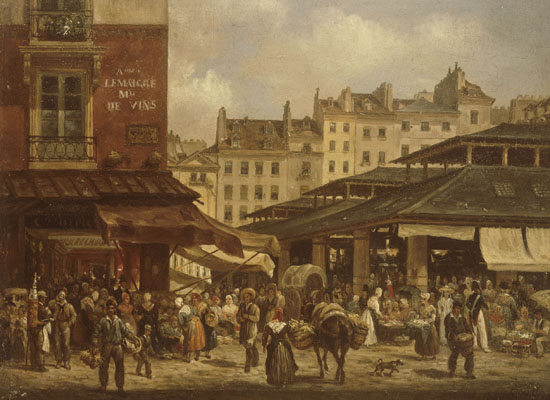Fr : version française / En: english version
The central market
Cities needed to organize their provisions to cope with population growth. Feeding the city was a business that employed a lot of people within the city walls, since all food was prepared on the spot. Bread and meat were the staples. Butchers were one of the first professional bodies created. Animals arrived on foot and were slaughtered near rivers to make it easier to dispose of the waste. Wheat and wine were brought in by boat.
In addition to the traders, porters and unloaders, the markets attracted other less savory characters who also worked the street: thieves, crooks, informers, beggars and prostitutes.
The Fat and the Thin
All along the footways on both sides of the road there were still many market gardeners, with other small growers from the environs of Paris, who displayed baskets containing their "gatherings" of the previous evening—bundles of vegetables and clusters of fruit. Whilst the crowd incessantly paced hither and thither, vehicles barred the road; and Florent, in order to pass them, had to press against some dingy sacks, like coal-sacks in appearance, and so numerous and heavy that the axle-trees of the vans bent beneath them. They were quite damp, and exhaled a fresh odor of seaweed. From a rent low down in the side of one of them a black stream of big mussels was trickling.
Florent and Claude had now to pause at every step. The fish was arriving and one after another the drays of the railway companies drove up laden with wooden cages full of the hampers and baskets that had come by train from the sea coast. And to get out of the way of the fish drays, which became more and more numerous and disquieting, the artist and Florent rushed amongst the wheels of the drays laden with butter and eggs and cheese, huge yellow vehicles bearing colored lanterns, and drawn by four horses. The market porters carried the cases of eggs, and baskets of cheese and butter, into the auction pavilion, where clerks were making entries in note books by the light of the gas. Claude was quite charmed with all this uproar, and forgot everything to gaze at some effect of light, some group of blouses, or the picturesque unloading of a cart. At last they extricated themselves from the crowd.
Extract from "The Fat and the Thin" (Le Ventre de Paris) by Emile Zola, translated by Ernest Alfred Vizetelly



























